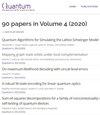使用更快的算法降低t计数
IF 5.1
2区 物理与天体物理
Q1 PHYSICS, MULTIDISCIPLINARY
引用次数: 0
摘要
在表征量子电路的成本指标中,$T$-count是最关键的成本指标之一,因为它的最小化在量子计算的各个领域,如容错量子计算和量子电路模拟中尤为重要。在这项工作中,我们通过提出具有低执行时间的高效的$T$ count优化器来解决$T$ count减少问题。特别是,我们大大提高了TODD的复杂性,TODD是目前在各种量子电路上提供最佳的$T$计数减少的算法。我们还提出了对算法的一些修改,这些修改可以显著降低$T$门的数量。此外,我们提出了另一种算法,该算法具有更低的复杂性,并且在大多数评估的量子电路中实现了更好或相等的$T$计数。我们还证明了在由$n$量子比特组成的Hadamard-free电路上执行我们的算法后得到的电路中$T$门数的上限为$n(n + 1)/2 + 1$,这改进了现有优化算法的最坏情况$T$-计数。由此,我们得到了Clifford$+T$电路中$T$门数的上界$(n + 1)(n + 2h)/2 + 1$,其中$h$是电路中内部Hadamard门的数目,即位于电路的第一个和最后一个$T$门之间的Hadamard门的数目。本文章由计算机程序翻译,如有差异,请以英文原文为准。
Lower T-count with faster algorithms
Among the cost metrics characterizing a quantum circuit, the $T$-count stands out as one of the most crucial as its minimization is particularly important in various areas of quantum computation such as fault-tolerant quantum computing and quantum circuit simulation. In this work, we contribute to the $T$-count reduction problem by proposing efficient $T$-count optimizers with low execution times. In particular, we greatly improve the complexity of TODD, an algorithm currently providing the best $T$-count reduction on various quantum circuits. We also propose some modifications to the algorithm which are leading to a significantly lower number of $T$ gates. In addition, we propose another algorithm which has an even lower complexity and that achieves a better or equal $T$-count than the state of the art on most quantum circuits evaluated. We also prove that the number of $T$ gates in the circuit obtained after executing our algorithms on a Hadamard-free circuit composed of $n$ qubits is upper bounded by $n(n + 1)/2 + 1$, which improves on the worst-case $T$-count of existing optimization algorithms. From this we derive an upper bound of $(n + 1)(n + 2h)/2 + 1$ for the number of $T$ gates in a Clifford$+T$ circuit where $h$ is the number of internal Hadamard gates in the circuit, i.e. the number of Hadamard gates lying between the first and the last $T$ gate of the circuit.
求助全文
通过发布文献求助,成功后即可免费获取论文全文。
去求助
来源期刊

Quantum
Physics and Astronomy-Physics and Astronomy (miscellaneous)
CiteScore
9.20
自引率
10.90%
发文量
241
审稿时长
16 weeks
期刊介绍:
Quantum is an open-access peer-reviewed journal for quantum science and related fields. Quantum is non-profit and community-run: an effort by researchers and for researchers to make science more open and publishing more transparent and efficient.
 求助内容:
求助内容: 应助结果提醒方式:
应助结果提醒方式:


